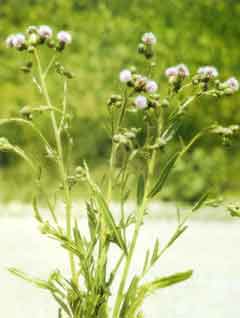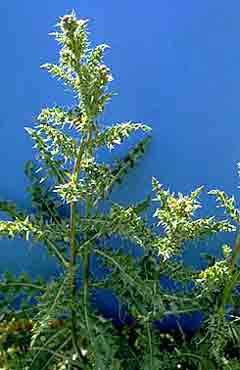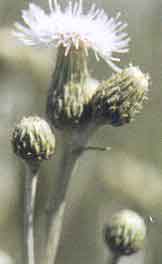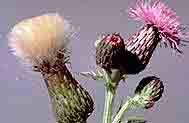(Cirsium arvense)
Description: Canada thistle is a perennial reproducing by creeping, freely sprouting horizontal roots and by seed. It grows in patches because of its root system and perennial nature. The extensive roots are fleshy and send up frequent new shoots. The stems are erect, hollow, smooth, or slightly hairy, up to 4 feet high and branched at the top. The plants are leafy but no wings or spiny appendages occur on the stems. The waxy leaves are oblong to lance-shaped and vary from very irregular and deeply cut to spiny-toothed on the margins to almost smooth with few or no spines. The color is usually bright green but the upper surface varies from dark to light, and the leaves are sometimes very light green and slightly hairy on the underside. The flower heads are numerous, small, compact, and vary from light lavender to rose-purple. The bracts on the heads are not spiny. The plant is dioecious, so male and female flowers are produced on separate plants. The seeds are oblong, flattened, curved, smooth, dark brown, and approximately 1/8 inch long.
Distribution: Canada thistle is declared a noxious weed throughout the United States and has long been recognized as a major agricultural pest, costing tens of millions of dollars in direct crop losses annually and additional millions in cost for control. Canada thistle is found in Iowa in cultivated fields, meadows, pastures, waste places, roadsides, and prairies. This weeds spreads by producing enormous quantities of seed that is carried by wind, mowers, and animals.
What’s the problem?: Canada thistle is one of Johnson County’s most problematic weeds. Canada thistle establishes quickly in an area and crowds out and displaces native plants and lowers plant diversity. The spreading horizontal roots also allow this invasive weed to move into uninfested areas to compete for light and moisture. Conservation Reserve Areas (CRP) can become infested, which violates set aside contracts. Row crops such as corn and soybeans can have decreased yield and marketability if infested with Canada thistle.
Management methods: Since its introduction into the United States in the 1600’s, Canada thistle has been recognized as one of the worst weeds in respect to ability to spread, ability to negatively impact agriculture, and its tenaciousness. Due to its perennial nature and extensive roots system, Canada thistle is very difficult to control, once well established. The best control method is to identify the weed early in its’ invasion, and to prevent infestation. Management is typically through hand-cutting, mowing, controlled burning, competitive seeding, and careful use of appropriate herbicides. Generally, mowing alone will not eliminate Canada thistle. Use of several of these methods will be necessary to reduce infestations to manageable levels. Typically, several or more years of management are required to deplete root reserves and the seed bank. Seeds can remain viable in the soil for 50 or more years.




Photos courtesy of Weeds of Nebraska and the Great Plains published by Nebraska Department of Agriculture, and King County, WA Noxious Weed Control Program
